Nako - Rangrik
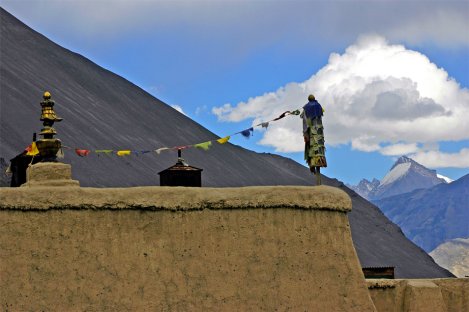 A single night at Nako was
not enough to do it justice but another treasure was in store 46km east of Kaza
at Tabo Gompa. The mud and timber boxes that nestle on the steep north bank of
the Spiti may look drab, but the multi-hued murals and stucco sculpture they
contain are some of the world's richest and most important ancient Buddhist art
treasures; the link between the cave paintings of Ajanta, and the more exuberant
tantric art that flourished in Tibet five centuries or so later. According to an
inscription in its main assembly hall, the monastery was established in 996 AD,
when Rinchen Zangpo. an emissary of King Yeshe Od of Guge, was disseminating
dharma across the northwestern Himalaya. In addition to the 158 Sanskrit
Buddhist texts he personally transcribed, the "Great Translator" brought with
him a retinue of Kashmiri artisans to decorate the temples. The only surviving
examples of their exceptional work are here at Tabo, at Alchi in Ladakh, and
Toling and Tsaparam gompas in Chinese-occupied western Tibet. Unfortunately
photography was not allowed, just a parting shot of Leo Pargial II over the
gompa's roof.
A single night at Nako was
not enough to do it justice but another treasure was in store 46km east of Kaza
at Tabo Gompa. The mud and timber boxes that nestle on the steep north bank of
the Spiti may look drab, but the multi-hued murals and stucco sculpture they
contain are some of the world's richest and most important ancient Buddhist art
treasures; the link between the cave paintings of Ajanta, and the more exuberant
tantric art that flourished in Tibet five centuries or so later. According to an
inscription in its main assembly hall, the monastery was established in 996 AD,
when Rinchen Zangpo. an emissary of King Yeshe Od of Guge, was disseminating
dharma across the northwestern Himalaya. In addition to the 158 Sanskrit
Buddhist texts he personally transcribed, the "Great Translator" brought with
him a retinue of Kashmiri artisans to decorate the temples. The only surviving
examples of their exceptional work are here at Tabo, at Alchi in Ladakh, and
Toling and Tsaparam gompas in Chinese-occupied western Tibet. Unfortunately
photography was not allowed, just a parting shot of Leo Pargial II over the
gompa's roof.
After leaving Tabo we
arrived late teatime at Munsel-ling school at Rangrik (3790m). Just a few kilometres
west of Kaza this was to be our home for the next week or two depending on
individual arrangements and an opportunity for the trekkers to acclimatise for
the high pass. We were greeted by a party of students in traditional
dress (the girls a little more committed than the boys - hey, what's new!) who
had been waiting patiently an hour or so for our arrival.
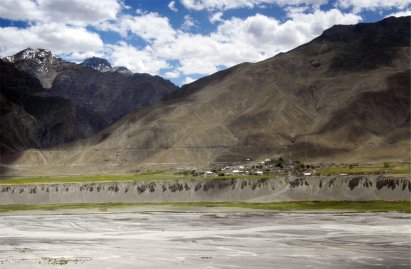
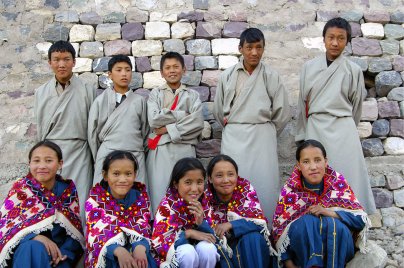
Rangrik
before crossing the bridge over the Spiti river
"At last!"
The following day there
was to be a celebration of the Dalai Lama's birthday in the nearby town of Kaza
and we were offered a lift in the school bus. After stocking up with life's
essentials (to us westerners anyway!) we headed for the sport's field and
waited. Eventually there was the sound of horns from up the hill and a colourful
procession was coming our way. What a spectacle, its drama accentuated by the
stark backdrop of the barren Himalaya. The flag being carried by the front
bearer below represents: blue-sky, white-air, red-fire, green-vegetation and
yellow-earth.
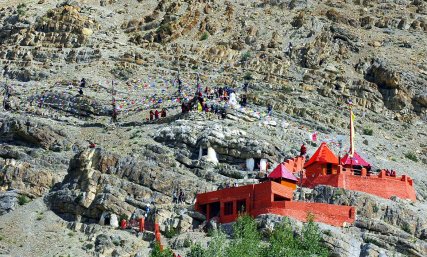
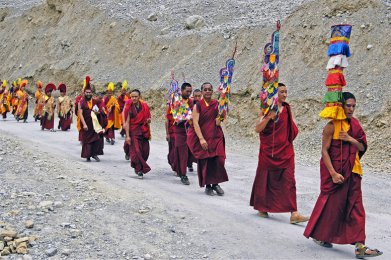
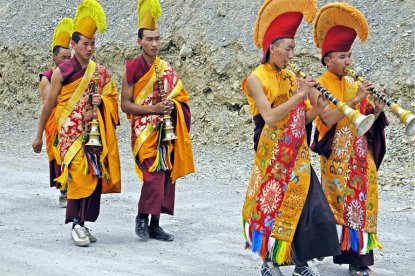
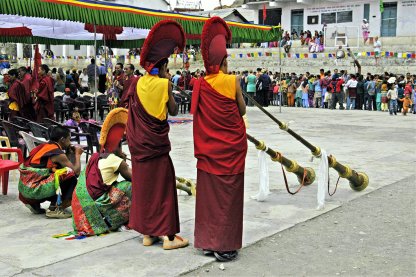
On our second day in
Rangrik we observed assembly in Munsel-ling school playground which compared to the UK is a prolonged,
regimented event and the discipline of the students is to be applauded.


High above the school stands
this impressive Buddha where the students assemble at full moon for celebration.
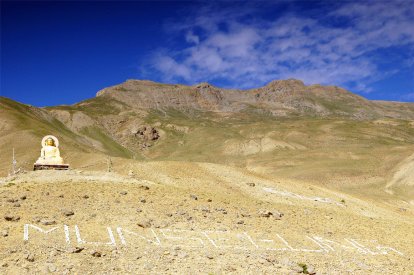
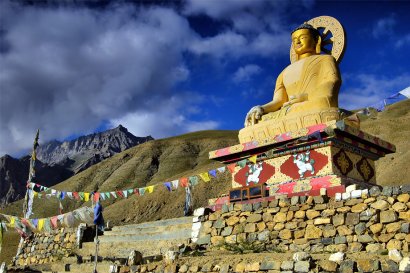
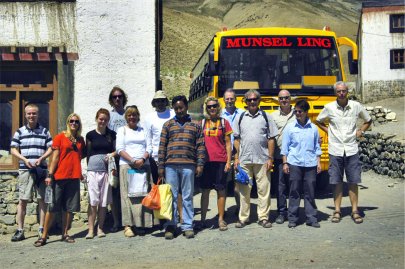
After assembly we were
given a tour of the school by the Principal, Tsering Dorje, pictured at the
front of our party (and the school bus!)
We started with
Kindergarten:
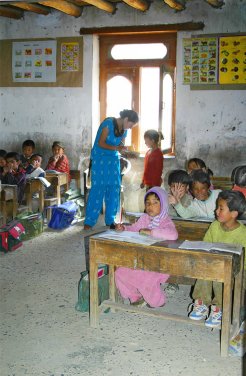
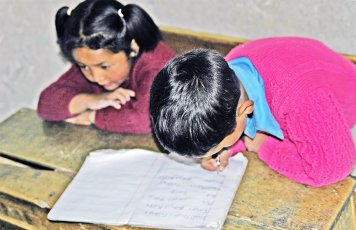
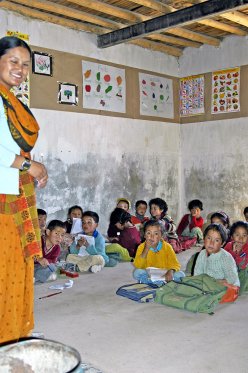
We were a little confused
at first relating age with size until we learned that the children are born with
an age of one!
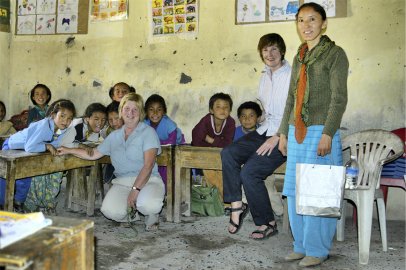
Caroline and Linda offered
their teaching expertise to help with Class 2A and are seen here with Kalzan, a
local teacher who we had met five years earlier near Dharamsala, when children
and staff had to board in hostels in Yol before there was a school in the Spiti
valley.
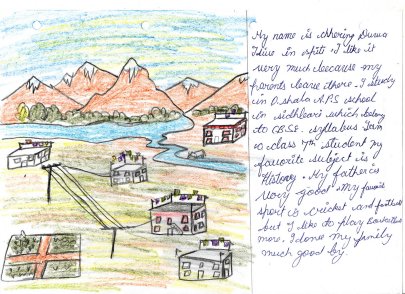
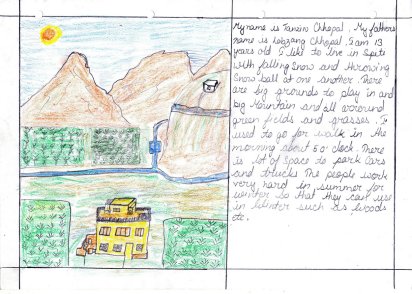
Some examples of children's work kindly donated by Rachel, a gap year student
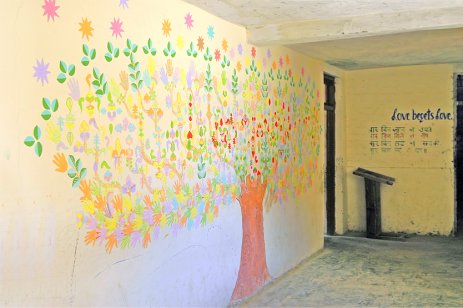
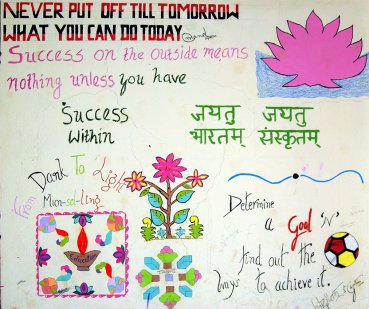

"Well known phrases and
sayings!" in the corridor outside fifth class (above) and the new library to be
(opposite)
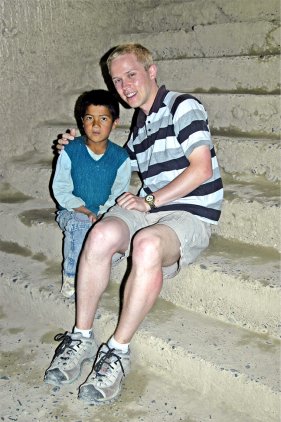
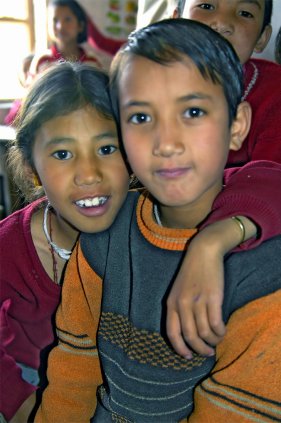
During our visit it gave
us the opportunity to meet the children we sponsor. Mark is seen here with
Nawang and "our child" Tenzin appears to have an admirer!
Much building work is in
progress:
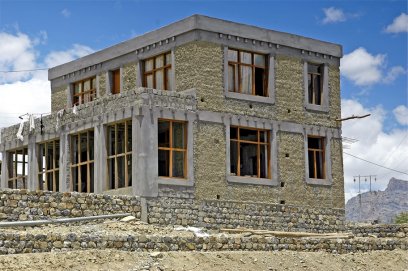
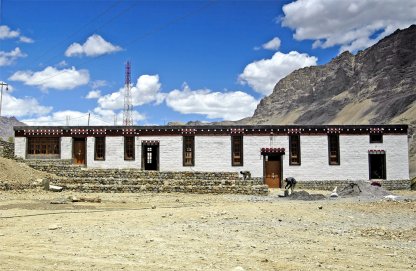
Medical Block
Cultural Hall
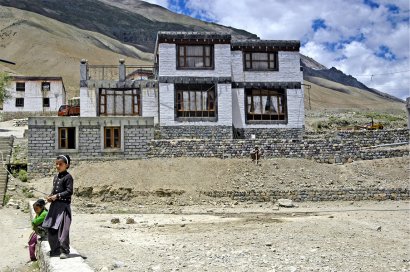
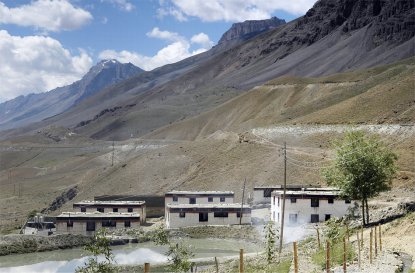
Administration Block
Hostels
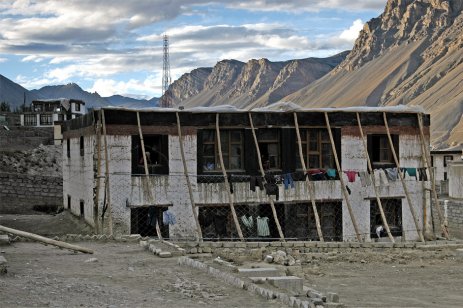
The "zing" in front of the
hostels is a reservoir used to irrigate the crops such as peas and barley and is
supplied with water from the aqueduct to the right which in turn is filled from
a dam in the mid-distance. Richard Gere has sponsored the hostel opposite and
named it after his father. The poles support clear plastic sheeting (seen on the
roof) which is draped over them during the severe winters to create a greenhouse
effect and keep the interior temperature at a constant twenty degrees
centigrade.
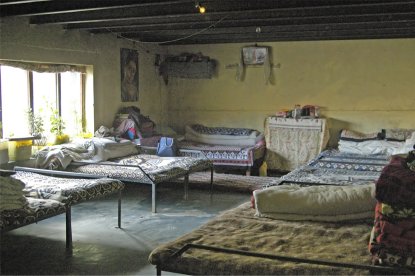

Interior of
hostel............................................and........................................enjoying
(?!) homework
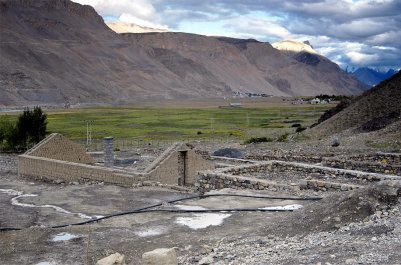

Greenhouse site
Bathroom site (with solar heating)
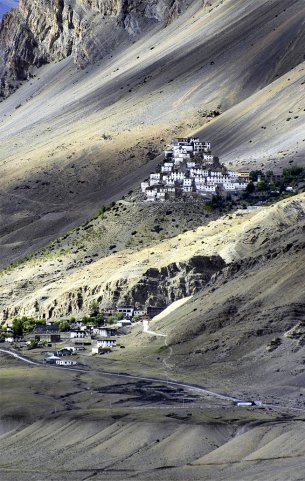
Key (just one translation!) monastery is visible just up the
valley and over the river from the school, set against a backdrop of
high mountains and ochre and grey scree covered cliffs. The white buildings
which stick to the steep sides of a windswept conical hillock are a picture-book
example of Tibetan architecture, and one of Himachal's most exotic spectacles.
Founded in the sixteenth century, Key is the largest monastery in the Spiti
valley, supporting a thriving community of lamas whose Rinpoche, Lo Chien Tulk
from Nako, is said to be the current incarnation of the "Great Translator"
Rinchen Zangpo. His glass-fronted quarters crown the top of the complex, reached
via crumbling stone steps that wind between the lamas' houses below.
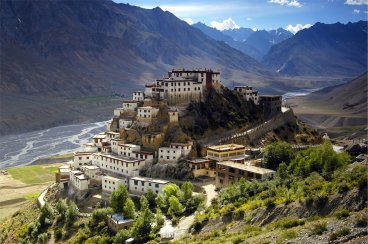
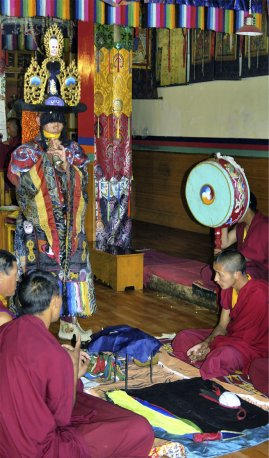
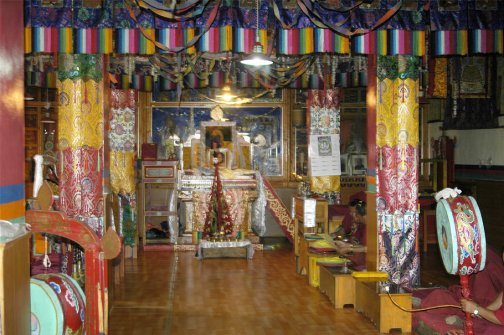
We were fortunate to be at the monastery during the new moon in
early July to witness a large festival celebrating the "burning of the demon" in
which chaam dances were followed by a procession that winds its way down to the
ritual ground below the monastery where a large butter sculpture is set on fire.
Pilgrims prostrate themselves on the ground for the procession of lamas to walk
over them.
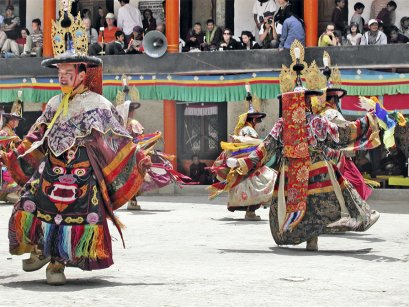
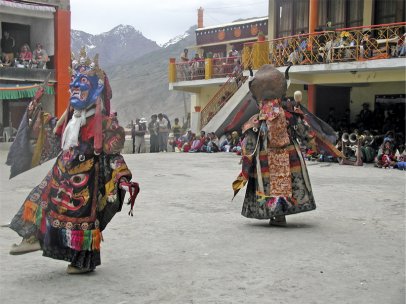
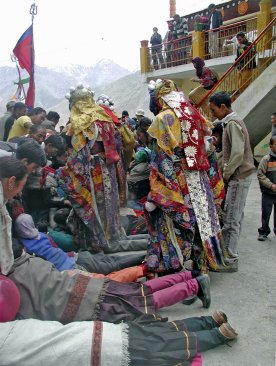
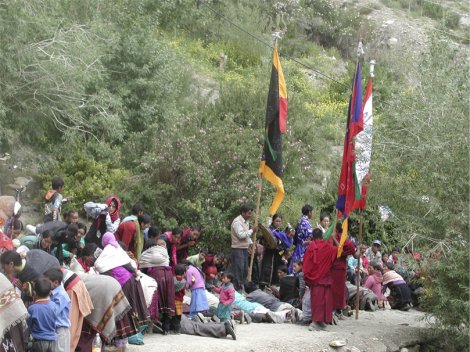
Next morning the School Sports Day got off to an early start with
long distance races and sprints followed by team events...........
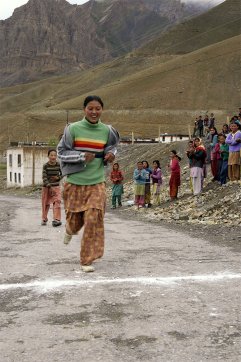
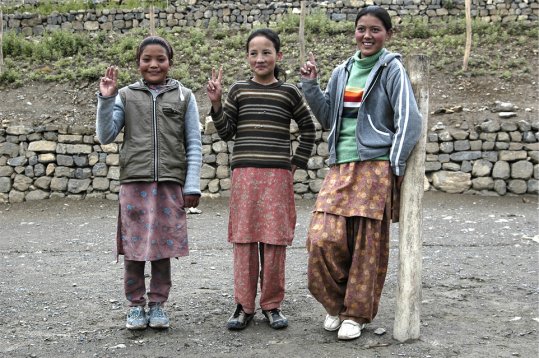
Girls 2.5km
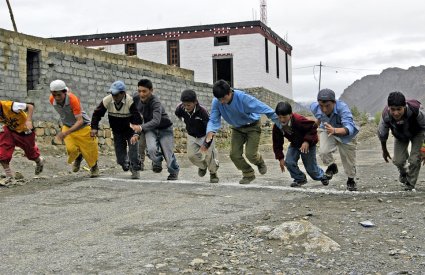
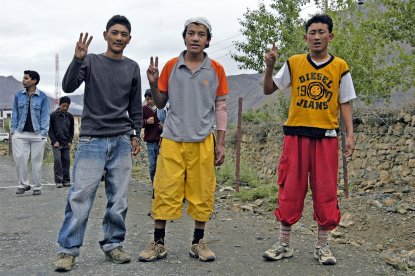
Start of the boys 100m
Winners of the boys 200m

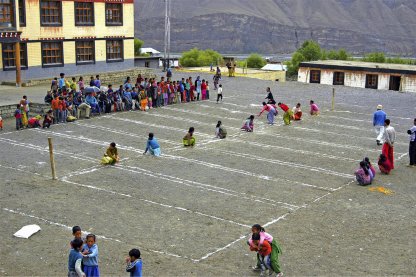
Volley-ball
Kho-kho
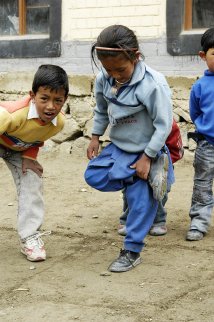

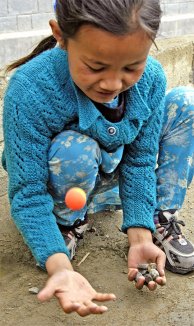
..................and fringe activities!
Following our pattern of alternating our attendance at school
functions with trips to nearby attractions we visited Dhankar the next day,
mid-way between Kaza and Tabo. Near the meeting of the Pin and Spiti rivers a
rough road veers off to the east for 12km to the village whose name means "a
place in the mountains unreachable for strangers" and which is home to another
monastery associated with the Great Translator, Rinchen Zangpo. Set against a
lunar landscape of crumbling cliffs, the Lha Opa Gompa dates back to the twelfth
century. The main interest, however, lies in the small chapel on the uppermost
peak behind the village of Dhankar - the Lhakang Gompa - with its brilliant
murals depicting the life of the Buddha. Probably painted in the seventeenth
century, the dominant bright red pigment has survived especially well. Although
some of the work has been vandalised, the scenes depicting the Buddha's birth in
the heavenly realm, his re-birth and life in Kapilavastu and his rejection of
worldly ways are spectacular.
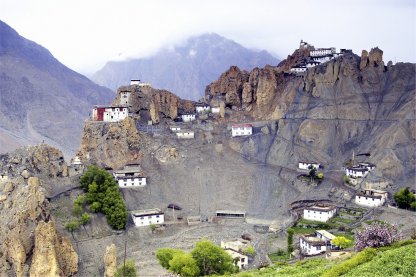
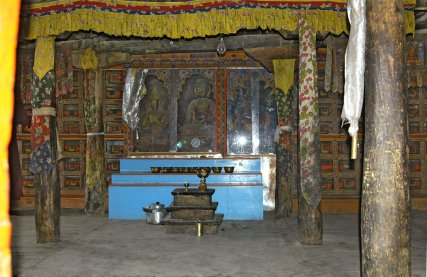
Dhankar
The Library
Our final "official engagement" was attendance at the annual
prize-giving ceremony followed by short plays and regional dances in traditional
costume. Great credit must be given to the teachers and all their helpers in
producing such an event and the students in learning their parts so accomplished
in English.

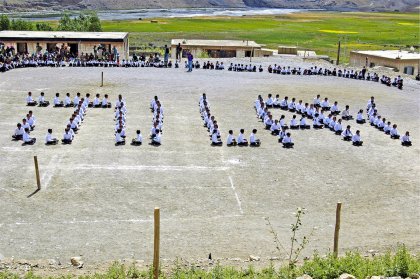
Welcome..................................................and....................................................hello!
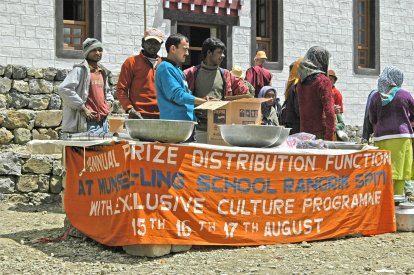
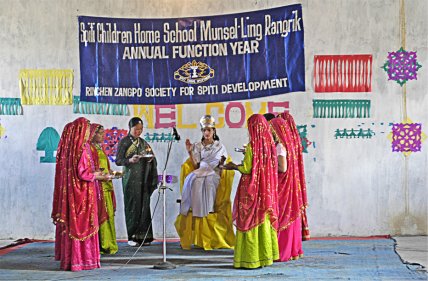
Pupils, staff, voluntary helpers and those involved in organising
sponsorship were all recognised in what was a memorable occasion. There is only
space for a handful of pictures from the event so my apologies to those not
included, and believe me no less merit, but appreciation must be extended to
Tsering Dorje, the school Principal for what must have been a harrowing day!
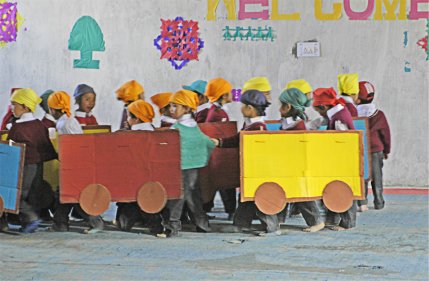
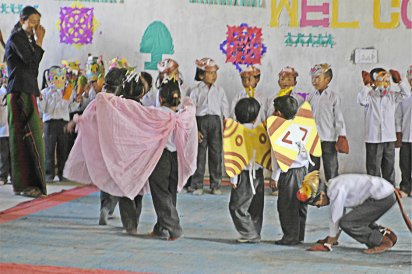
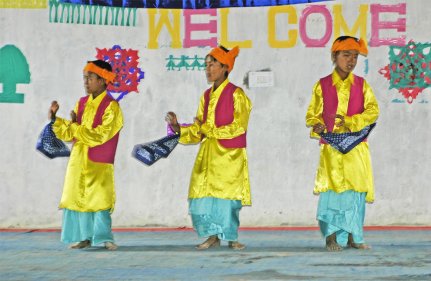
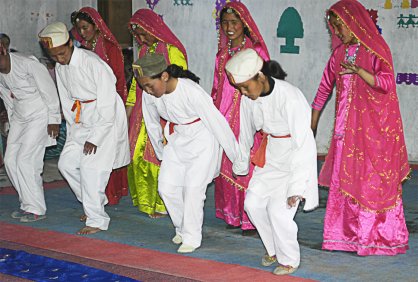
Punjabi dance and costume
Mundi dance and costume
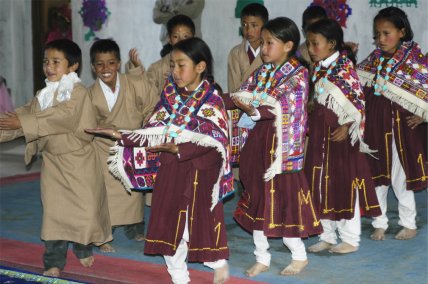
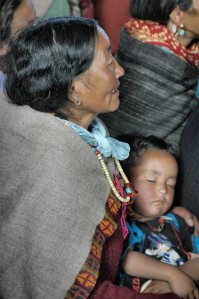
Traditional Spiti dance and costume..............................and captive
audience (well, gran anyway!)
The following afternoon was the staff versus tourists cricket
match which turned out to be a narrow victory for the home team. Maybe we could
say they had an altitude advantage?
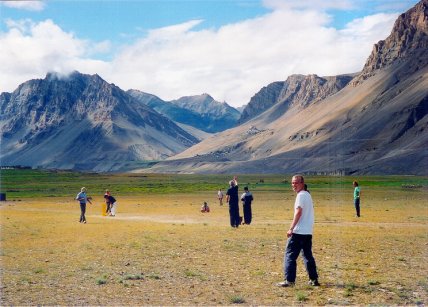
And then it was parting of the ways...............
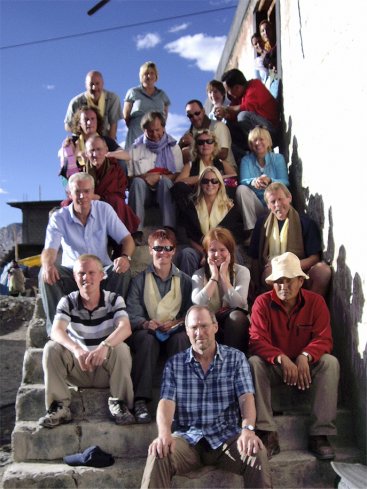
As well as expressing our heartfelt gratitude to Tsering for the
school's gracious hospitality we also needed to acknowledge the work done by
Tashi Namgyal, the gentleman pictured lower right in the above photograph. It
was he who inaugurated the Rinchen Zangpo Society for Spiti Development and we
have been able to see for ourselves the progress made in the provision of
education for these Tibetan children. Having met Tashi in Yol five years ago
when building work was in its infancy it is gratifying to see the results of his
ideals and hard work.
NEXT PAGE
 A single night at Nako was
not enough to do it justice but another treasure was in store 46km east of Kaza
at Tabo Gompa. The mud and timber boxes that nestle on the steep north bank of
the Spiti may look drab, but the multi-hued murals and stucco sculpture they
contain are some of the world's richest and most important ancient Buddhist art
treasures; the link between the cave paintings of Ajanta, and the more exuberant
tantric art that flourished in Tibet five centuries or so later. According to an
inscription in its main assembly hall, the monastery was established in 996 AD,
when Rinchen Zangpo. an emissary of King Yeshe Od of Guge, was disseminating
dharma across the northwestern Himalaya. In addition to the 158 Sanskrit
Buddhist texts he personally transcribed, the "Great Translator" brought with
him a retinue of Kashmiri artisans to decorate the temples. The only surviving
examples of their exceptional work are here at Tabo, at Alchi in Ladakh, and
Toling and Tsaparam gompas in Chinese-occupied western Tibet. Unfortunately
photography was not allowed, just a parting shot of Leo Pargial II over the
gompa's roof.
A single night at Nako was
not enough to do it justice but another treasure was in store 46km east of Kaza
at Tabo Gompa. The mud and timber boxes that nestle on the steep north bank of
the Spiti may look drab, but the multi-hued murals and stucco sculpture they
contain are some of the world's richest and most important ancient Buddhist art
treasures; the link between the cave paintings of Ajanta, and the more exuberant
tantric art that flourished in Tibet five centuries or so later. According to an
inscription in its main assembly hall, the monastery was established in 996 AD,
when Rinchen Zangpo. an emissary of King Yeshe Od of Guge, was disseminating
dharma across the northwestern Himalaya. In addition to the 158 Sanskrit
Buddhist texts he personally transcribed, the "Great Translator" brought with
him a retinue of Kashmiri artisans to decorate the temples. The only surviving
examples of their exceptional work are here at Tabo, at Alchi in Ladakh, and
Toling and Tsaparam gompas in Chinese-occupied western Tibet. Unfortunately
photography was not allowed, just a parting shot of Leo Pargial II over the
gompa's roof.





























































